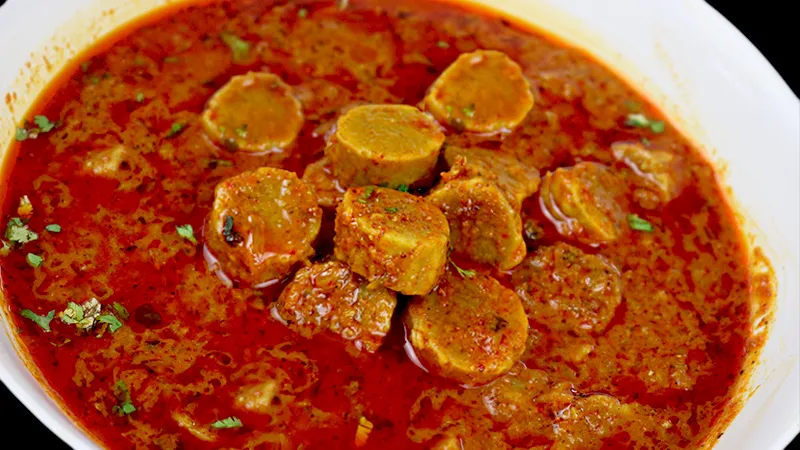Sarson ka Saag Recipe: Sarson ka Saag isn’t just a dish for North Indian winters; it’s an emotion. Crafted from fresh winter greens and seasoned with onions, tomatoes, and spices, the result is a creamy, coarse gravy bursting with warm, rustic flavors. Serve it with a generous dollop of homemade butter, hot makki roti, and jaggery for a heartwarming winter meal.
Traditionally, making Sarson ka Saag involves a lengthy process. The leafy greens are first cooked for about 90 minutes in a large earthen pot until they’re soft and mushy. They’re then ground to a coarse paste using a wooden whisk, before finally tempering with ghee, onions, tomatoes, and a few spices.

However, this simplified Sarson ka Saag Recipe offers a quicker alternative. Here’s why you should try this recipe this winter:
- By pressure cooking the greens, the cooking time is reduced by nearly half. The entire dish comes together in less than an hour.
- It’s an excellent way to incorporate greens and other fresh winter produce into your family’s diet.
- Despite its long list of ingredients, this dish is surprisingly easy to make.
- It can be made in a large batch and frozen for future use.
- Make this recipe ahead as it tastes even better the next day.
- The combination of leafy greens makes this dish a rich source of fiber, antioxidants, and vitamins.
- This recipe is naturally gluten-free and can be easily made vegan by excluding ghee and curd.
Ingredients you’ll need:
- Sarson/mustard leaves
- Greens (spinach and bathua leaves)
- Radish and radish greens
- Ginger and garlic
- Green garlic (optional)
- Makki atta (corn flour)
- Ghee
- White butter

How to make sarson ka saag:
- Pressure cook mustard leaves, bathua, spinach, radish leaves, radish, green garlic, ginger, garlic, and green chilies with a cup of water for 2-3 whistles or approximately 10-15 minutes.
- Let the steam escape completely before opening the pressure cooker.
- Let it cool and grind only the greens to a coarse paste, reserving any water in the pressure cooker.
- Heat mustard oil and ghee, add jeera, ginger, garlic, green chili paste.
- Sauté for a minute, add onions, and cook until translucent.
- Add tomatoes, chili powder, and salt; cook until mushy.
- Add the greens mixture to the onion-tomato paste.
- Also, add the reserved water plus an additional half cup of water and cook for 5-10 minutes until you see some oil on top.
- Whisk together curd and makki atta; add the mixture along with jaggery to the pan. Bring it to a quick boil while stirring continuously to avoid lumps.
- Once it starts boiling, reduce the flame, adjust water if required, and cook covered for 5-10 minutes or until you see specks of fat floating on top. Add a big dollop of butter on top.
- Serve hot with makki ki rotis.

How to Wash the Greens:
- After separating the leaves from the stem, place the leaves in a large bowl.
- Fill the bowl with water and swish the leaves around.
- Remove the leaves, and you’ll notice dirt settling at the bottom of the water.
- Discard the water and repeat the process a few times until there is no more dirt.
- Always wash the leaves just before using to prevent rotting from moisture.
FAQs:
Can I Freeze Sarson Ka Saag?
Yes, absolutely! Sarson ka saag is freezer-friendly and stays well for up to a month, with or without the tadka. Cook a large batch, allow it to cool, and store it in zip lock bags in the freezer. Defrost, reheat, add tadka, and enjoy delicious saag every time.
Why Is My Sarson Ka Saag Bitter?
Sarson or mustard leaves naturally have a slightly bitter taste. If it’s excessively bitter, reduce the quantity of mustard leaves and add more spinach or other greens. The tempering process with green garlic, ginger, and tomatoes will help reduce bitterness.
Tips to Help You Nail Sarson Ka Saag:
- Wash the leaves thoroughly under running water to remove impurities.
- If using the traditional method with a wooden whisk, finely chop all greens before adding them to the pressure cooker.
- Achieve a coarse, creamy texture using a stick blender or pulse the mixture in a grinder.
- This recipe works well with frozen greens; thaw and squeeze out excess liquid before cooking.
- Refrigerate extra saag without tempering; it stays good in the fridge for up to 4 days and can be frozen for up to a month.
- For a more wholesome dish, add paneer or chicken to the saag.
- Celebrate winter with sarson ka saag, topped with fresh homemade butter, served with hot makki rotis and jaggery for a wholesome and comforting meal. While best with makki roti, it also pairs well with roti, paratha, or steamed basmati rice.

